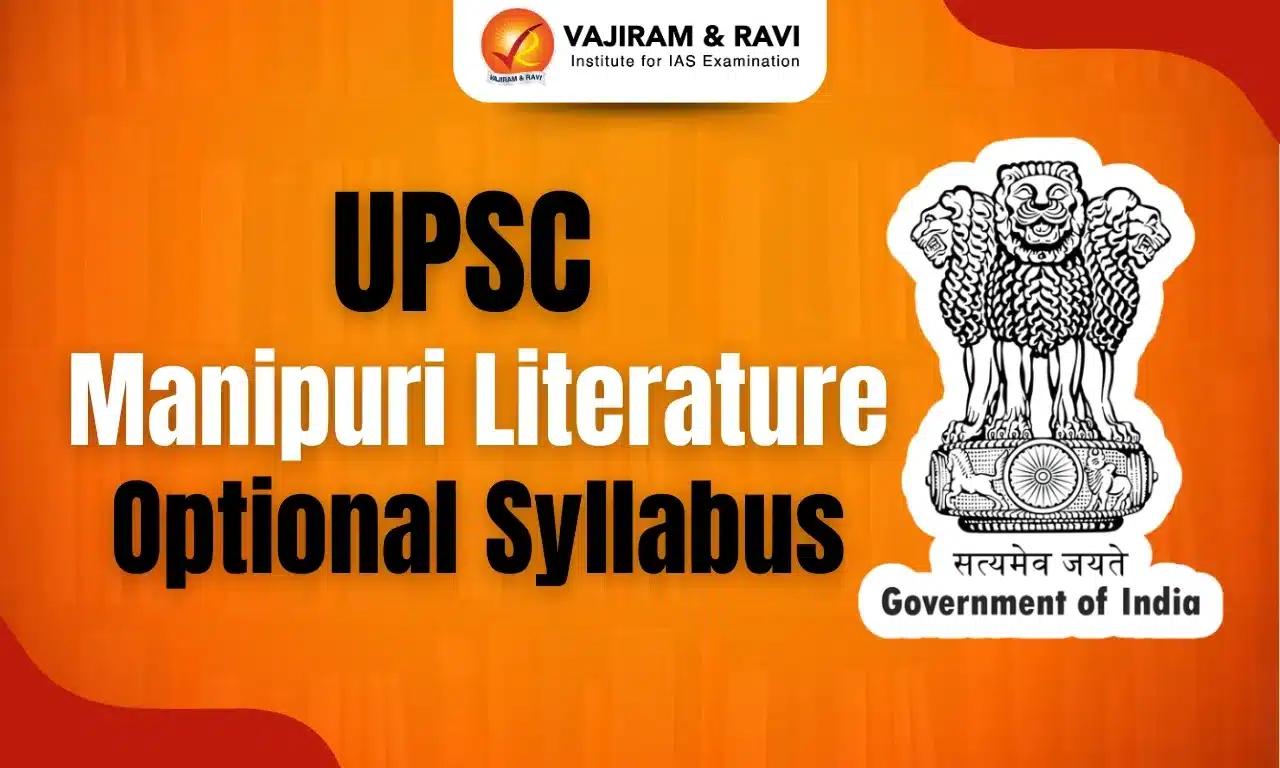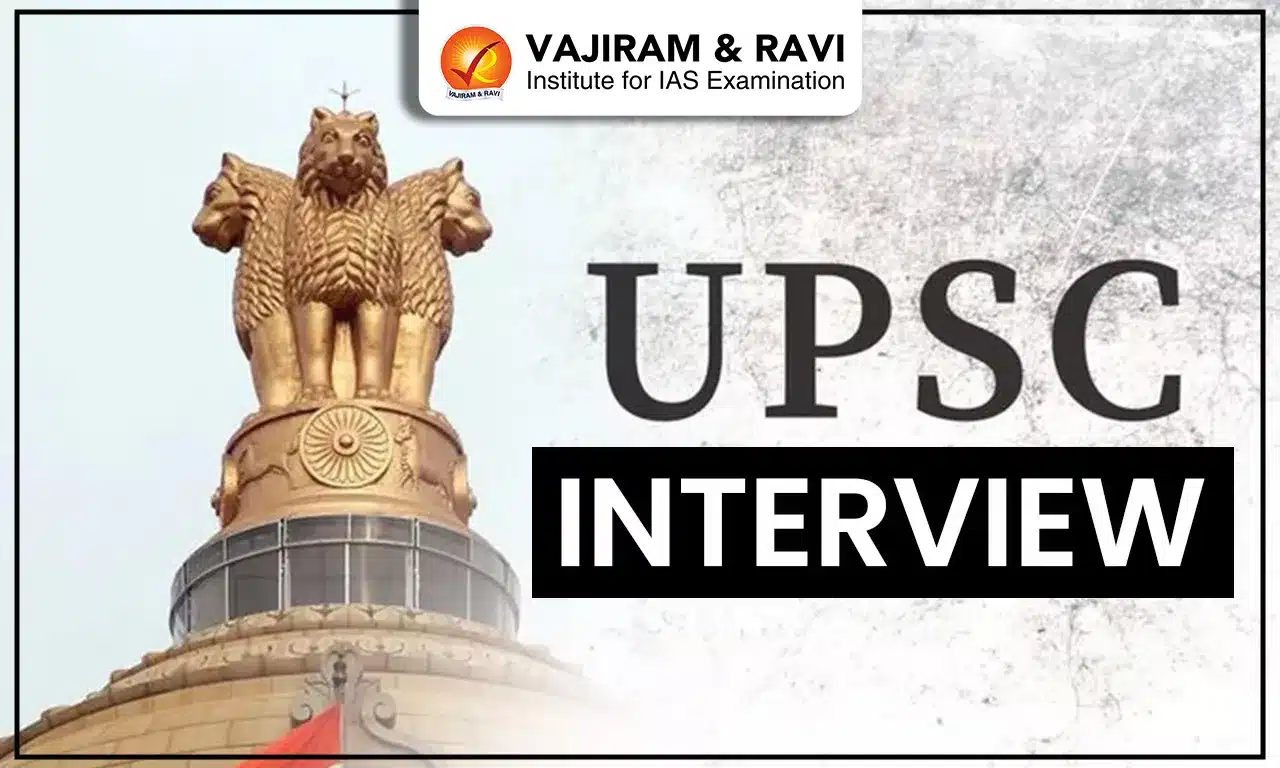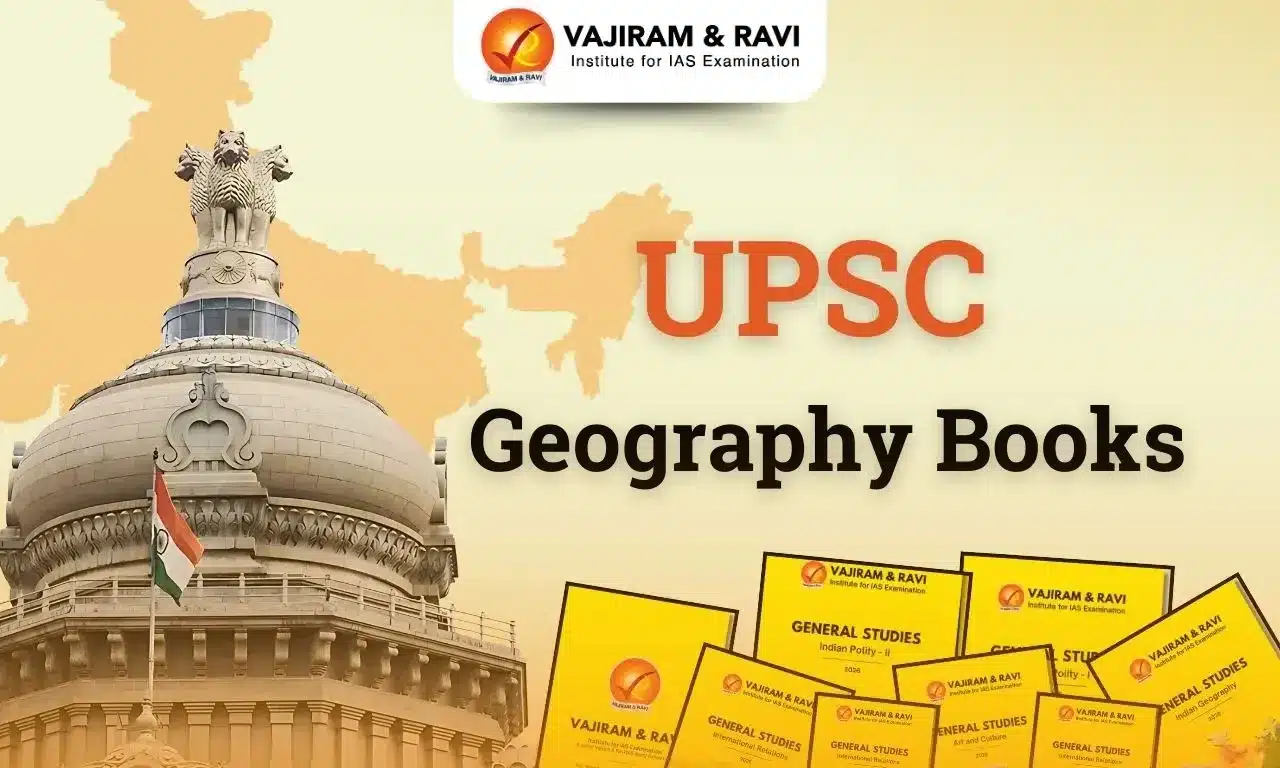UPSC Manipuri Literature Optional Syllabus assesses the manipuri language and literary culture of the language. The Manipuri Literature syllabus has two papers, paper 1 and paper 2 each carrying 250 marks each. UPSC Manipuri Literature Optional Paper 1 focuses on historical development and classical literature in Manipuri and Paper 2 focuses on contemporary literature and critical analysis of manipuri texts. In this article, we are going to cover the UPSC Manipuri Literature Optional Syllabus.
UPSC Manipuri Literature Syllabus
UPSC Manipuri Literature Optional Syllabus covers all the important classical and modern manipuri author works and texts. Various styles of literature, linguistic alteration and cultural settings are covered including genres like prose, poetry, drama and literary criticism from the classical to modern times.
|
Overview of UPSC Manipuri Optional Syllabus |
||
|
Mains Papers |
Subject |
Marks |
|
Paper VI |
Manipuri Literature Optional Paper 1 |
250 |
|
Paper VII |
Manipuri Literature Optional Paper 2 |
250 |
|
TOTAL |
500 |
|
|
Time Duration |
3 hours |
|
UPSC Manipuri Literature Syllabus for Optional Paper 1
UPSC Manipuri Literature Syllabus for Optional Paper 1 covers the classical and historical texts of Manipuri Literature. The syllabus begins with the origin and evolution of the Manipuri language, encompassing its historical development, phonetic structure, morphology, and syntax. It delves into classical and medieval Manipuri literature, focusing on key works and their cultural significance. Candidates are expected to critically analyze ancient texts by notable authors such as Hijam Anganghal and Khwairakpam Chaoba, examining their thematic concerns, narrative techniques, and stylistic features. The study of traditional folklore includes folk narratives, mythological tales, and legends that reflect the societal values and belief systems of the region. Additionally, the syllabus covers the formative stages of Manipuri prose and poetry, highlighting the early literary contributions of poets and writers.
|
Manipuri Optional Syllabus for UPSC Paper 1 |
|
|
Section |
Topics of Manipuri UPSC Syllabus |
|
Section-A |
|
|
Language |
General characteristics of Manipuri Language and history of its development; importance and status among the Tibeto-Burman Languages of North-East India; recent development in the study of Manipuri Language; evolution and study of old Manipuri script. |
|
Significant features of Manipuri Language |
Phonology: Phoneme-vowels, consonants juncture, tone, consonant cluster and its occurrence, syllable-its structure, pattern and types. |
|
Morphology: Word-class, root and its types; affix and its types; grammatical categories-gender, number, person, case, tense and aspects, process of compounding (samas and sandhi). |
|
|
Syntax: Word order; types of sentences, phrases and clause structures. |
|
|
Section-B |
|
|
Literary History of Manipuri |
Early period (up to 17th Century)–Social and cultural background; Themes, diction and style of the works. |
|
Medieval period (18th and 19th Century)-Social, religious and political background; Themes, diction and style of the works. |
|
|
Modern period-Growth of major literary forms; change of Themes, diction and style. |
|
|
Manipuri Folk Literature |
Legend, Folktale, Folksong, Ballad, Proverb and Riddle. |
|
Aspects of Manipuri Culture |
Pre-Hindu Manipuri Faith; Advent of Hinduism and the process of syncretism; |
|
Performing arts-Lai Haraoba, Maha Ras; |
|
|
Indigenous games-Sagol Kangjei, Khong Kangjei, Kang. |
|
UPSC Manipuri Literature Syllabus for Optional Paper 2
UPSC Manipuri Literature Optional Paper 2 Syllabus focuses on the modern developments in Manipuri literary traditions. It encompasses contemporary poetry, drama, prose, and literary criticism, highlighting the evolution of themes, styles, and narrative techniques in the modern era. The paper includes an in-depth study of notable poets and their works that reflect present-day social, cultural, and philosophical concerns. It also examines the growth of Manipuri drama through the contributions of significant playwrights and their impact on modern theatre. Modern prose—including short stories, novels, and essays—is analyzed for its thematic richness and stylistic innovation. A substantial portion of Paper 2 is dedicated to literary criticism, where candidates engage with the perspectives of prominent Manipuri critics and theoretical frameworks. The syllabus further explores contemporary literary trends, movements, and the growing influence of translation in expanding the reach and relevance of Manipuri literature.
|
Manipuri Optional Syllabus for UPSC Paper 2 |
|
|
Section |
Topics of Manipuri UPSC Syllabus |
|
Section-A |
|
|
Old Manipuri Literature |
O. Bhogeswar Singh (Ed.): Numit Kappa |
|
M. Gourachandra Singh (Ed.): Thawanthaba Hiran |
|
|
N. Khelchandra Singh (Ed.): Naothingkhong Phambal Kaba |
|
|
M. Chandra Singh (Ed.): Panthoibi Khongul |
|
|
Medieval Manipuri Literature |
M. Chandra Singh (Ed.): Samsok Ngamba |
|
R.K. Snahal Singh (Ed.): Ramayana Adi Kanda |
|
|
N. Khelchandra Singh (Ed.): Dhananjoy Laibu Ningba |
|
|
O. Bhogeswar Singh (Ed.): Chandrakirti Jila Changba |
|
|
Section-B - Modern Manipuri Literature |
|
|
Poetry |
Kh. Chaoba Singh: Pi Thadoi, Lamgi Chekla Amada, Loktak |
|
Dr. L. Kamal Singh: Nirjanata, Nirab Rajani |
|
|
A. Minaketan Singh: Kamal Da, Nonggumlalk Khoda |
|
|
L. Samarendra Singh: Ingagi Nong, Mamang Leikai Thambal Satle |
|
|
E. Nilakanta Singh: Manipur, Lamangnaba |
|
|
Shri Biren: Tangkhul Hui |
|
|
Th. Ibopishak: Anouba Thunglaba Jiba |
|
|
Dr. L. Kamal Singh: Biswa Prem |
|
|
Shri Biren: Chaphadraba Laigi Yen |
|
|
Th. Ibopishak: Norok Patal Prithivi |
|
|
Epic |
A. Dorendrajit Singh: Kansa Bodha |
|
H. Anganghal Singh: Khamba-Thoibi Sheireng (San-Senba, Lei Langba, Shamu Khonggi Bichar) |
|
|
Drama |
S. Lalit Singh: Areppa Marup |
|
G.C. Tongbra: Matric Pass |
|
|
A. Samarendra: Judge Saheb ki Imung |
|
|
Novel |
Dr. L. Kamal Singh: Madhabi |
|
H. Anganghal Singh: Jahera H. |
|
|
Guno Singh: Laman |
|
|
Pacha Meetei: Imphal Amasung, Magi Ishing, Nungsitki Phibam |
|
|
Short Story |
Kanchi Warimacha (Pub) Manipur University 1997 (Ed.) |
|
R.K. Shitaljit Singh: Kamala Kamala |
|
|
M.K. Binodini: Eigi Thahoudraba Heitup Lalu |
|
|
Kh. Prakash: Wanom Shareng |
|
|
Parishadki Khangatlaba Warimacha (Pub) Manipuri Sahitya Parishad 1994 (Ed.) |
|
|
S. Nilbir Shastri: Loukhatpa |
|
|
R.K. Elangba: Karinunggi |
|
|
Anouba Manipuri Warimacha (Pub) The Cultural Forum Manipur 1992 (Ed.) |
|
|
N. Kunjamohon Singh: Ijat Tanba |
|
|
E. Dinamani: Nongthak Khongnang |
|
|
Prose |
Warenggi Saklon [Due Part] (Pub) The Cultural Forum Manipur 1992 (Ed.) |
|
Kh. Chaoba Singh: Khamba-Thoibigi Wari Amasung Mahakavya |
|
|
Kanchi Wareng (Pub) Manipur University, 1998 (Ed.) |
|
|
B. Manisana Shastri: Phajaba |
|
|
Ch. Manihar Singh: Lai-Haraoba |
|
|
Apunba Wareng (Pub) Manipur University, 1986 (Ed.) |
|
|
Ch. Pishak Singh: Samaj Amasung Sanskriti |
|
|
M.K. Binodini: Thoibidu Warouhouida |
|
|
Eric Newton: Kalagi Mahousa (translated by I.R. Babu) |
|
|
Manipuri Wareng (Pub) The Cultural Forum Manipur 1999 (Ed.) |
|
|
S. Krishnamohan Singh: Lan |
|
UPSC Manipuri Literature Optional Books
The best books to prepare for UPSC Manipuri Literature are:
- "History of Manipuri Literature" by Th. Bira Singh, as the book will give full and comprehensive history from the ancient period till the present age.
- "Cheitharol Kumbaba" by Ningthouja Khelchandra Singh is necessary for reading the Manipuri classical prose.
- A study of modern Manipuri prose and poetry cannot be accomplished without the works like "Madhabi" by M.K. Binodini Devi and "Yeningthagi Eeshei" by Arambam Samarendra.
- "Manipuri Sahitya Suwarjya" by R.K. Jhalajit Singh and "Manipuri Short Stories" by Pacha Meitei are necessary for literary criticism and contemporary literature.
- Some key sources are the journals and research papers in universities and literary institutes that carry quite significant details on intense analysis for an understanding of Manipuri literary criticism and modern trends.
Last updated on December, 2025
→ Check out the latest UPSC Syllabus 2026 here.
→ Join Vajiram & Ravi’s Interview Guidance Programme for expert help to crack your final UPSC stage.
→ UPSC Mains Result 2025 is now out.
→ UPSC Notification 2026 is scheduled to be released on January 14, 2026.
→ UPSC Calendar 2026 is released on 15th May, 2025.
→ The UPSC Vacancy 2025 were released 1129, out of which 979 were for UPSC CSE and remaining 150 are for UPSC IFoS.
→ UPSC Prelims 2026 will be conducted on 24th May, 2026 & UPSC Mains 2026 will be conducted on 21st August 2026.
→ The UPSC Selection Process is of 3 stages-Prelims, Mains and Interview.
→ UPSC Result 2024 is released with latest UPSC Marksheet 2024. Check Now!
→ UPSC Prelims Result 2025 is out now for the CSE held on 25 May 2025.
→ UPSC Toppers List 2024 is released now. Shakti Dubey is UPSC AIR 1 2024 Topper.
→ UPSC Prelims Question Paper 2025 and Unofficial Prelims Answer Key 2025 are available now.
→ UPSC Mains Question Paper 2025 is out for Essay, GS 1, 2, 3 & GS 4.
→ UPSC Mains Indian Language Question Paper 2025 is now out.
→ UPSC Mains Optional Question Paper 2025 is now out.
→ Also check Best IAS Coaching in Delhi
UPSC Manipuri Literature Optional FAQs
Q1. Who is the father of Manipuri literature?+
Q2. What is the 7/5/3 rule in UPSC?+
Q3. Which is the toughest optional in UPSC?+
Q4. Is Literature a good optional for UPSC?+
Q5. Which is the easiest optional subject for UPSC?+

















